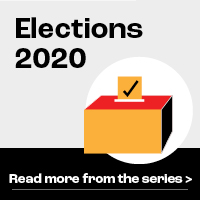On Social Security, healthcare, housing and food support, Joe Biden and Donald Trump offer different visions to older New Yorkers.

Donald Trump and Joe Biden are vying to be the oldest person ever elected president. Neither of them mentions that, but whichever man wins next month will have a big impact on issues of particular concern to the millions of older Americans who don’t live in the White House.

Along with the questions that concern their younger counterparts, older Americans responding to an AARP poll say candidates’ positions on Social Security and Medicare, prescription drugs costs and protections for nursing homes will influence their votes. New York’s older adults, advocates say, have particular interest in issues linked to living on fixed incomes in a very expensive city, such as affordable housing.
While every poll puts New York in Biden’s camp regardless of how seniors vote, older Americans nationally could play a key role in this year’s election. They are more likely to vote than younger people—with 71 percent of them casting ballots in 2016 as opposed to 61 percent of the population as a whole—and account for more than a quarter of voters in Florida.
Seniors have voted for the Republican candidate in every presidential election since 2000, going for President Trump over Hillary Clinton 52 percent to 45 percent in 2016. There are indications, though, that seniors might switch their allegiance this year. A recent CNN poll showed Biden capturing 60 percent of the age group compared to 39 percent for Trump.
“A lot of people are focused on the youth vote,” says Joe Stelling of AARP New York, but voters 50 and over are “going to decide the outcome of this election,” so candidates need to pay attention to the issues that concern them.
Undoubtedly aware of that, both candidates have laid out their positions on some senior issues on their websites and granted interviews to the AARP Bulletin.
Social Security
Both Biden and Trump pledge support for Medicare and Social Security, although Trump has wavered in the past. In January he said he would look at cutting entitlements, including Social Security, a statement White House aides quickly walked back. Then in August, in an effort to bolster an economy reeling from the effects of COVID, Trump signed an executive order to defer collection of the payroll tax (also known as FICA) that provides 90 percent of the funding for Social Security. Trump told AARP that deferring the payroll tax “poses no risk to the Social Security system and puts more money in the pockets of hard-working Americans.” In any event, most companies apparently ignored the order and continued to deduct the taxes from their employees’ paychecks.
Trump has also said he would try to “terminate”—not merely defer—the payroll tax if he is re-elected, a move that could jeopardize the entire Social Security system. “We will be ending that tax. We’ll be terminating that tax,” Trump said in August. Some Trump aides have said the president does not plan to terminate the tax but meant that he would simply not try to collect any payroll taxes that had been deferred.
Trump could find a mechanism other than the payroll tax to fund the program, but has not offered any proposal or indicated how he would keep the financially beleaguered programs solvent—with or without FICA.
While Trump may (or may not) end the payroll tax, Biden proposes increasing it on people making $400,000 a year or more. Currently people pay the tax on about $137,000 of income but nothing beyond that. Biden would keep that cap for people earning between $137,000 and $400,000 but institute the tax on all income for people above $400,000. This, he says, would make Social Security “secure for a long, long time.”
Health Issues
Healthcare has long been a concern for older Americans. COVID-19, says Stelling, brought it to the fore, with people wondering whether they will be able afford care or a vaccine, if and when one is available.
Biden and Trump have clashed over controlling prices for prescription drugs. While people 65 and over account for 12 percent of the U.S. population, they use 34 percent of prescription drugs.
In 2019, Trump boasted that he had brought drug prices down for the first time in 51 years. Politifact, however found that the administration did not have evidence to back up this claim, although it said prices might not have increased as much as in previous years.
Trump has signed four executive orders aimed at reducing prescription drug prices, two focusing on Medicare recipients. He hopes to ensure that the U.S. can buy drugs for the same price as other countries, where the cost may be 80 percent less. This, he predicted at the presidential debate last month, would bring drug prices down by 80 or 90 percent. For that to happen, though, the secretary of Health and Human Services would have to draft and implement a complicated set of rules, FactCheck.org found.
The administration reportedly came close to negotiating a major deal to reduce drug prices this summer but, according to the New York Times, talks broke down when drug companies rejected the White House chief of staff’s plan to have them pay for $100 gift cards—some called them “Trump cards”— for seniors to purchase prescription drugs. The cards were to go out by Election Day.
While the talks seem dead, the plan for the cards lives on. In September Trump announced he would send $200 “gift cards” for prescription drug purchases to seniors by Election Day. Media reports indicate the administration is racing to meet that deadline, but might not deliver the cards—which some Democrats have denounced as a taxpayer-funded re-election ploy by the president—until after Election Day.
Biden would allow Medicare to negotiate drug prices with pharmaceutical companies. On his web site, he says he would take other steps to control prices, including establishing a board to determine a reasonable price for new treatments; improving the supply of generic drugs, which are usually cheaper than brand-name medications; allowing more consumers to buy drugs from other countries; and limiting price increases for drugs used in government programs, including Medicare.
Both candidates in their interviews with AARP indicated they see controlling drug prices as key to ensuring that Medicare remains financially viable. Trump says improving management of the system is also vital. “There is a big thing on waste, fraud and abuse, and we’ll take care of that,” he told AARP.
Extending Medicare to all Americans, which Biden does not support but some Democrats have advocated, would pose a major threat to the system, Trump says: “It will ruin coverage. It’s a disaster. It’s a very dangerous thing they’re playing with.”
Biden, on the other hand, sees Trump’s repeated pledge to get rid of the Affordable Care Act, or Obamacare, as a threat to seniors. The plan, he says, strengthened Medicare by providing coverage for preventive health care, such as screenings, and eliminating a gap in drug coverage. “The Affordable Care Act is still a big deal-especially for older Americans,” Biden’s website says. “But, every day over the past nine years, the Affordable Care Act has been under relentless attack.”
Food and shelter
By many measures, health care is fairly accessible in New York compared to other states. Other necessities are not. With this in mind, LiveOn NY monitors SNAP, the Supplemental Nutrition Assistance Program previously known as Food Stamps, and various affordable housing programs.
SNAP is key, LiveOn’s director of public policy Katelyn Andrews says, “because it can help an individual make ends meet and avoid having to make decisions with diverse health effects such as skipping medication.”
A 2019 report by Hunter College’s Food Policy Center found 21 percent of New York’ s 1.6 million people 65 and older live in poverty, and one in 10 faces food insecurity. Many of those eligible for SNAP do not apply, Andrews says. “It is important that there are no barriers for people getting the aid,” she says. “We have to let people know this is something any one can and should utilize to make ends meet.”

Last year, the Trump administration proposed changes, including stricter work requirements for adults less than 50 years old without children to receive benefits. If enacted, the Urban Institute found, the changes would have kept about 290,000 New Yorkers from receiving SNAP and reduced the value of benefits by more than 17 percent. This month, a federal district judge blocked the work rule, calling it “arbitrary and capricious.” And in September Trump signed a bill that included $8 billion in nutrition assistance.
Biden has called for increasing SNAP benefits by 15 percent during the current recession and for temporarily giving low-income families an extra $100 a month for food. His running mate Sen. Kamala Harris introduced a bill to increase SNAP benefits during the pandemic and is also the sponsor of the FEMA Empowering Essential Deliveries (FEED) Act, which would allow the federal government to pay restaurants for preparing meals for the hungry.
Housing
Biden has offered a number of plans for housing that Rachel Fee, executive director of the New York Housing Conference, thinks could help seniors better afford living in New York. For one, she says, he has proposed making the Section 8 program, in which people pay up to 30 percent of their income for rent with a government-issued voucher making up the rest, available to everyone who qualifies for it. As of last year, 138,705 New Yorkers were on the wait list for Section 8 housing.
Such a major expansion of Section 8, Fee says, would not be easy but would be “a real gamechanger…not only to keep a roof over their heads but to meet other needs.”
Biden would also increase construction of affordable housing, ramp up the low-income housing tax credit and increase Section 202, a program that has provided supportive housing for the elderly.
Prodded by Congress, the Trump administration has resumed spending on Section 202, which had been largely moribund since 2011, but none of the money allocated so far has gone to New York, according to Linda Couch, vice president for housing policy at LeadingAge, an advocacy group for the aging.
Funding for the Older Americans Act is also important to New Yorkers, Andrews says, calling it “a small but mighty program” that funds “much of what is integral to older adults to help them connect with their community and thrive.” Among other things, the act provides a substantial portion of the funding for New York’s senior centers as well as food and transportation programs.
Trump signed a reauthorization of the measure, originally enacted in 1965, in March. New York’s funding under the program has decreased, however, with grants falling by $5 million (adjusted for inflation) from fiscal year 2010 to fiscal year 2018.
Voting
Beyond the candidates and their policy positions, voting itself is a major issue in 2020, particularly for older New Yorkers who may not feel safe going to their normal polling places on November 3.
Democrats, like Biden, generally support giving people a range of options, allowing them to vote by mail, early or in person on Election Day.
In his interview with AARP, Trump reiterated his warning that many mail-in ballots would get lost and urged people to show up in person. He says, “The voting booths are going to be extremely safe. Nobody is going to have a problem if they go out and vote.”
For those with doubts, New York is allowing everyone to vote absentee.
Stelling said AARP would have liked all eligible New Yorkers to have automatically received mail-in ballots—to use or not—as they did in the primary, as opposed to having to ask for one.
“The most important thing now is for everyone to know the rules so they can get out there and vote safely,” he says.
Early voting is also available, beginning October 24.









One thought on “Septuagenarians Running for President Differ on Key Issues for Older New Yorkers”
Very informative, well-written article.